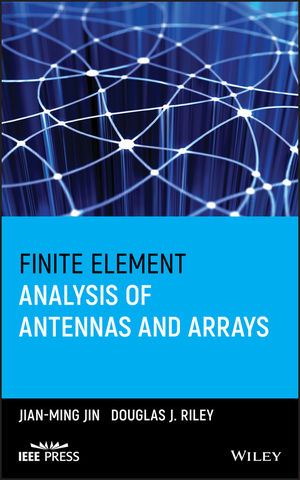Finite Element Analysis of Antennas and ArraysISBN: 978-0-470-40128-6
Hardcover
488 pages
December 2008, Wiley-IEEE Press
 This is a Print-on-Demand title. It will be printed specifically to fill your order. Please allow an additional 10-15 days delivery time. The book is not returnable.
|
||||||
Preface xi
1 Introduction 1
1.1 Numerical Simulation of Antennas 1
1.2 Finite Element Analysis Versus Other Numerical Methods 2
1.3 Frequency- Versus Time-Domain Simulations 5
1.4 Brief Review of Past Work 7
1.5 Overview of the Book 9
References 11
2 Finite Element Formulation 17
2.1 Finite Element Formulation in the Frequency Domain 17
2.2 Finite Element Formulation in the Time Domain 24
2.3 Modeling of Complex Materials 27
2.3.1 Modeling of Electrically and Magnetically Lossy Materials 28
2.3.2 Modeling of Electrically Dispersive Materials 30
2.3.3 Modeling of Magnetically Dispersive Materials 36
2.3.4 Modeling of Doubly Dispersive Lossy Materials 40
2.3.5 Validation Examples 43
2.4 Solution of the Finite Element Equations 49
2.5 Higher-Order and Curvilinear Finite Elements 50
2.6 Summary 52
References 53
3 Finite Element Mesh Truncation 55
3.1 Absorbing Boundary Conditions 55
3.1.1 First-Order Absorbing Boundary Condition 55
3.1.2 Second-Order Absorbing Boundary Condition 56
3.2 Perfectly Matched Layers 61
3.2.1 PML in Terms of Stretched Coordinates 62
3.2.2 PML as an Anisotropic Material Absorber 64
3.2.3 PML for Truncating the Computational Domain 65
3.2.4 Finite Element Implementation of PML 67
3.2.5 ABC-Backed, Complementary, CFS, and Second-Order PMLs 72
3.3 Boundary Integral Equations 76
3.3.1 Frequency-Domain Formulations 77
3.3.2 Time-Domain Formulations 86
3.3.3 Treatment of the Infinite Ground Plane 93
3.4 Summary 96
References 97
4 Hybrid FETD–FDTD Technique 100
4.1 FDTD Method 101
4.2 PML Implementation in FDTD 106
4.2.1 FDTD Stretched-Coordinate PML 107
4.2.2 FDTD Anisotropic-Medium PML 111
4.3 Near-to-Far-Field Transformation in FDTD 113
4.4 Alternative FETD Formulation 117
4.5 Equivalence Between FETD and FDTD 120
4.6 Stable FETD–FDTD Interface 124
4.6.1 Initial Approaches 125
4.6.2 Stable Formulation 128
4.7 Building Hybrid Meshes 131
4.8 Wave-Equation Stabilization 134
4.9 Validation Examples 137
4.10 Summary 140
References 143
5 Antenna Source Modeling and Parameter Calculation 147
5.1 Antenna Feed Modeling 147
5.1.1 Current Probe 148
5.1.2 Voltage Gap Generator 152
5.1.3 Waveguide Feed Model 155
5.2 Plane-Wave Excitation 164
5.2.1 Total-Field Formulation 167
5.2.2 Scattered-Field Formulation 170
5.2.3 Total- and Scattered-Field Decomposition Approach 171
5.3 Far-Field Pattern Computation 176
5.4 Near-Field Visualization 179
5.5 Summary 182
References 184
6 Modeling of Complex Structures 187
6.1 Thin-Material Layers and Sheets 188
6.1.1 Impedance Boundary Conditions 188
6.1.2 Shell Element Formulation 197
6.2 Thin Wires and Slots 201
6.2.1 Thin Wires 201
6.2.2 Thin Slots 208
6.3 Lumped-Circuit Elements 217
6.3.1 Coupled First-Order Equations 218
6.3.2 Wave Equation 219
6.3.3 Example 222
6.4 Distributed Feed Network 224
6.5 System-Level Coupling Example 230
6.5.1 Internal Dispersive Material Calibration 230
6.5.2 External Illumination and Aperture Coupling 234
6.6 Summary 234
References 236
7 Antenna Simulation Examples 240
7.1 Narrowband Antennas 240
7.1.1 Coaxial-Fed Monopole Antenna 240
7.1.2 Monopole Antennas on a Plate 241
7.1.3 Patch Antennas on a Plate 243
7.1.4 Conformal Patch Antenna Array 245
7.2 Broadband Antennas 247
7.2.1 Ridged Horn Antenna 247
7.2.2 Sinuous Antenna 249
7.2.3 Logarithmic Spiral Antenna 251
7.2.4 Inverted Conical Spiral Antenna 253
7.2.5 Antipodal Vivaldi Antenna 254
7.2.6 Vlasov Antenna 255
7.3 Antenna RCS Simulations 257
7.3.1 Microstrip Patch Antenna 258
7.3.2 Standard Gain Horn Antenna 259
7.4 Summary 262
References 262
8 Axisymmetric Antenna Modeling 264
8.1 Method of Analysis 264
8.1.1 Finite Element Formulation 264
8.1.2 Mesh Truncation Using Perfectly Matched Layers 267
8.1.3 Mesh Truncation Using Boundary Integral Equations 269
8.1.4 Far-Field Computation 272
8.2 Application Examples 273
8.2.1 Luneburg Lens 273
8.2.2 Corrugated Horn 276
8.2.3 Current Loop Inside a Radome 281
8.3 Summary 282
References 282
9 Infinite Phased-Array Modeling 284
9.1 Frequency-Domain Modeling 285
9.1.1 Periodic Boundary Conditions 285
9.1.2 Mesh Truncation Techniques 294
9.1.3 Extension to Skew Arrays 298
9.1.4 Extension to Scattering Analysis 300
9.1.5 Application Examples 300
9.2 Time-Domain Modeling 303
9.2.1 Transformed Field Variable 304
9.2.2 Mesh Truncation Techniques 306
9.2.3 General Material Modeling 310
9.2.4 Application Examples 316
9.3 Approximation to Finite Arrays 325
9.4 Summary 332
References 333
10 Finite Phased-Array Modeling 336
10.1 Frequency-Domain Modeling 337
10.1.1 FETI–DPEM1 Formulation 337
10.1.2 FETI–DPEM2 Formulation 345
10.1.3 Nonconforming Domain Decomposition 350
10.1.4 Application Examples 355
10.2 Time-Domain Modeling 363
10.2.1 Dual-Field Domain-Decomposition Method 364
10.2.2 Domain Decomposition for Iterative Solutions 371
10.2.3 Application Examples 376
10.3 Summary 382
References 385
11 Antenna–Platform Interaction Modeling 388
11.1 Coupled Analysis 389
11.1.1 FETI–DPEM with Domain Decomposition 390
11.1.2 Hybrid FETD–FDTD with Domain Decomposition 393
11.1.3 Hybrid FE–BI Method with FMM Acceleration 399
11.2 Decoupled Analysis 405
11.2.1 Near-Field Calculation 406
11.2.2 Far-Field Evaluation by Numerical Methods 406
11.2.3 Far-Field Evaluation by Asymptotic Techniques 409
11.2.4 Direct and Iterative Improvements 416
11.3 Summary 417
References 418
12 Numerical and Practical Considerations 421
12.1 Choice of Simulation Technologies 421
12.2 Frequency- Versus Time-Domain Simulation Tools 422
12.3 Fast Frequency Sweep 424
12.4 Numerical Convergence 425
12.5 Domain Decomposition and Parallel Computing 427
12.6 Verification and Validation of Predictions 428
12.7 Summary 429
References 429
Index 431



